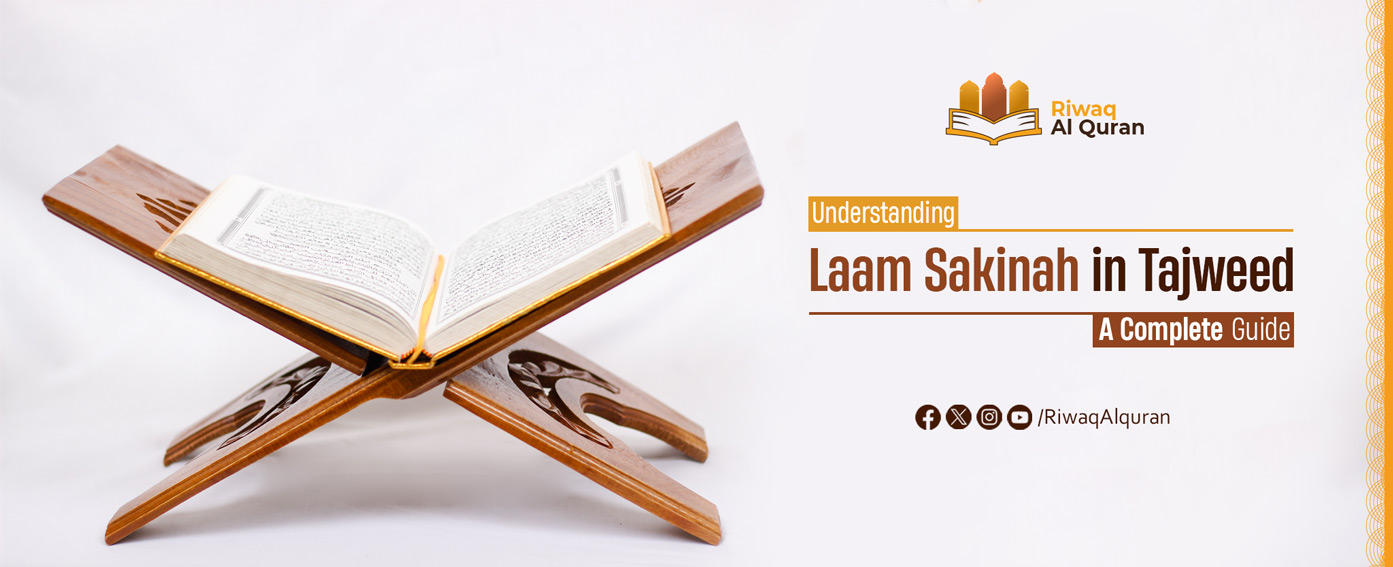By laam Sakinah rules, we mean how to pronounce the Arabic letter Laam (ل) with no vowel, written as (ل) without any diacritics or with the Sukoon sign in the Mushaf (A small head of ح above the letter).
It is used at any of the points: starting, center, or end of the word. At times, it is used as an additional letter that is added to the word like ٱلْمُلْك and sometimes it is used as a part of a word that can’t be detached from it like الَّذِي. To understand how we read this letter differently depending on the condition, it is important to learn the different Laam Sakinah rules.
Table of Contents
What Is Laam Sakinah?
Laam Sakinah refers to the letter Laam (ل) when it carries a Sukoon (a state of no vowel) and is pronounced lightly or merged depending on the letters that follow it. It appears in various contexts, including within words, phrases, or as part of the definite article “Al-” in Arabic grammar.


Five Laam Sakinah Rules with Examples
After covering the rules of Meem Sakinah, Noon Saakin Rules with Examples in these blogs, It is time now to learn more about the Laam Sakinah rules. There are five rules of Laam Sakinah in the Quran, which are explained below with the help of examples. All these kinds of Laam Sakinah rules adhere to two rules: Izhaar and Idghaam.
1. Laam Tareef
Laam Tareef (لام التعريف) is the definite article of Arabic alif-laam (الـ) added at the beginning of the common nouns to make them clearly defined or proper nouns. It comes after Hamzatul Wasl (همزة وصل) – an alif (ا) with the letter (ص) written over it (ٱ). However, we don’t place (ص) on top of it in writing since we know it is there, and no word in the Arabic language begins with alif (only alif with hamza (أ)).
It is added before the Laam Tareef to help us know how to pronounce it. If it comes in the beginning, it is read like we are starting from it, and if there is some other letter before it, we drop it and connect it with the previous letter, e.g., we read ٱَلاَرْض as “Al-Ardh” when it starts from Hamzatul Wasl, and we drop it and join it with the previous letter like وَٱلْاَرْض recited as “Wal-Ardh”. Laam Tareef is divided into two types:
Laam Qamariyya
When any of the Moon letters or Huroof Al-qamariyya (هـ ,ﻱ ,ﻭ ,ﻡ ,ﻙ ,ﻕ ,ﻑ ,ﻍ ,ﻉ ,ﺥ ,ﺡ ,ﺝ ,ﺏ ,أ) follows the Laam, it is read with Izhaar meaning obviousness. It is called Laam Qamariyya. For instance, ٱلْحَجّ is read as “Al-Hajj” and ٱَلْبَيْت as “Al Bayt”.
Some examples of Huroof Al-Qamariyya from Al-Quran are as follows:
- الْفَجْر
- الْجِنَّةِ
- الْبِلَادِ
- الْفَلَقِ
- الْحَمْدُ
- الْعَرْشِ
Laam Shamsiyya
When any of the Sun letters or Huroof Al-Shamsiyya (ﻥ ,ﻝ ,ﻅ ,ﻁ ,ﺽ ,ﺹ ,ﺵ ,ﺱ ,ﺯ ,ﺭ ,ﺫ ,ﺩ ,ﺕ) follows the Laam, it is read with Idghaam meaning merging but without the Ghunna (nasal sound). It is called Laam Shamsiyya. For instance, ٱلنَّعِيمِ is read as “An-Naeem” and الرُّوحُ as “Ar-Rooh”.
Some examples of Huroof Al-Shamsiyya from the Quran are as follows:
- السَّمِیْعُ
- التَّغَابُنِ
- الرَّسُولَ
- الصُّبْحِ
- السَّمَاءُ
- الرَّحْمَـٰنُ
For more information, check out our blog, which illustrates the rules of Laam Shamsiya and Laam Qamariya in detail.
2. Laam Sakin in Noun (Ism)
The second type of the Laam Sakinah rule is the one that comes with nouns. Laam Sakin in noun appears within the noun (Ism) and is always read with Izhaar. Examples include:
- سَلْسَبِيلًا
- سُلْطَان
- فُلْكِهِمْ
3. Laam Sakin in Verb (Fi’l)
Laam Sakin in verbs appears in the center or end of the verb. We read it with Izhaar if a letter comes after Laam Sakin in the verb, leaving out Laam and Raa. For example:
- قُل أَنْتُم
And when Laam and Raa come after Laam Sakin in the verb, we read it with Idghaam. The example for this type includes:
- أَقُل لَّكُم
- قُل رَّبِّ
4. Laam Sakin in Particle (Harf)
If Laam Sakin appears at the end of the particle and if the successive letter (first letter of the second word) is Laam or Raa, we do Idghaam, i.e., the Laam merged into the following letter without Ghunna, such as:
- هَل لَّكُم
- بَل رَّب
We use the Izhaar rule if any letter appears after the particles, except for Laam and Raa. An example of this includes
- هَلْ أنْتُم
- بَلْ هُم
5. Laam Sakin in Commanding Verb
The last type of all the Laam Sakinah rules is the one in the commanding verb. If (ثم، و، ف) appears in front of Laam Sakin in the present tense verb, usually beginning with ي, this Laam Sakin is Laam in the commanding verb. Example include:
- ثُمَّ لْيَقْضُ
- وَلْيُوفُوا
Types of Laam in Arabic Grammar
In Arabic grammar, Laam (ل) appears in various forms and serves different purposes based on its function and context. For example:
- Laam Al-Jar (لام الجر)
- Laam Al-Tawkeed (لام التوكيد)
What Is Laam Alif?
Laam Alif (لا) is a combination of the Arabic letters Laam (ل) and Alif (ا). It often appears in the middle or end of words as a decorative ligature, particularly in Arabic calligraphy. In Quranic text, Laam Alif occurs within specific words, and its pronunciation follows Tajweed rules. It has no grammatical function and is part of the word’s structure, as seen in “لَا” (laa, meaning “no”).
Laam Alif differs from the Laam of Al-Ta’reef (لام التعريف), which is used in the definite article “Al-” (أل) to make nouns definite. Laam Al-Ta’reef plays a grammatical role and follows Tajweed rules based on the letter that follows it (e.g., الشَّمس or القمر). In contrast, Laam Alif is purely structural and does not indicate definiteness.
How to Learn the Rules of Laam Effectively?
Learning the rules of Laam Sakinah can be simple if you follow these steps and approach them with consistent practice and focus:
- Understand the Concept
- Revise the Rules of Laam Sakinah Regularly
- Focus on Laam in the Definite Article
- Memorize the Solar and Lunar Letters
- Practice with Tajweed Examples
- Use a Teacher or Tajweed App for Guidance


Start Your Journey with Riwaq Al Quran’s Tajweed Course!
To help you with this, Riwaq Al Quran presents the Quran with Tajweed Course, which enables students to study and learn all the rules defined for Quran recitation, including the Laam Sakinah rules. So, without further hesitation, join the course and start this rewarding endeavor now!
We offer several courses such as:
- Online courses for kids.
- Online Quran classes for kids and adults.
- Online Arabic courses
- Online Ijazah courses
- Online Islamic Studies courses.
Here are a sample of our set of Quran Courses that will be helpful for you:
- Online Tafseer Course: Delve into Quranic meanings with our insightful online Tafseer course.
- Noorani Qaida Online: Learn Quranic basics efficiently through our Noorani Qaida online program.
- Online Quran Recitation Course: Enhance Quranic recitation skills through our expert-led online course.
- Online Tajweed Classes: Master Tajweed rules for beautiful Quranic recitation in online classes.
- Quran Memorization Online Course: Memorize the Quran effectively with our specialized online memorization course.
- Online Qirat Course: Explore diverse Qirat styles with our comprehensive online Qirat course.
- Online Quran Classes for Kids: Nurture a love for the Quran in kids through interactive online classes.
Conclusion
Learning the Laam Sakinah rules is vital for precise and beautiful Quranic recitation. Understanding the different contexts and rules—whether it’s Laam Tareef, Laam in nouns, verbs, or particles—will help you pronounce each word correctly!
Learning these rules is crucial as the Quran is Allah’s book and deserves to be recited correctly. The importance becomes evident with this verse: “… And recite the Quran with measured recitation. (Al-Muzzammil: 4)




































